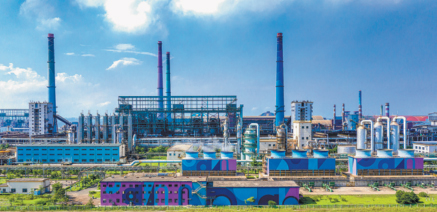Companies step up use of tech for ecologically friendly transformation
A number of giant projects on Zhanjiang's Donghai Island, Guangdong province, are not only key drivers for industrial growth but also examples of green development for others to follow.
They have launched innovation-driven technologies and cooperative projects to accelerate the green transformation in industrial development as part of their commitment to serving China's goals in carbon peak and neutrality.
Baosteel Zhanjiang Iron and Steel is the first of the three jumbo projects — each involving an investment of over $10 billion — that have settled on the island.
The company has made great efforts to realize green and ultra-low-carbon development by treating wastewater, solid waste and air pollutants; developing green energy; adopting low-carbon steelmaking techniques; and getting involved in circular development.
It has taken the lead in China's steelmaking industry to realize zero wastewater discharge, to have solid waste totally recycled and to reduce emissions to an ultra-low level.
Baosteel Zhanjiang has 23 sets of water treatment systems, capable of treating all the wastewater and recycling 98 percent of it at present.
The company established its first system for zero wastewater discharge in 2019, then the first of its kind in China. Its second system was in place in March to make sure the wastewater treatment capacity will suffice when the third blast furnace becomes operational.

The Baosteel Zhanjiang premises feature a garden-like environment. CHINA DAILY
The steelmaker has spent 4.4 billion yuan ($602.8 million) on the systems for reducing emissions from its three blast furnaces to an ultra-low level and it is probably the first steelmaker worldwide to have realized desulfurization and denitrification of coke oven flue gas simultaneously, according to the company.
The company has built eight facilities disposing of solid waste and 11 channels for reusing the recycled waste. As a result, its annual solid waste treatment and recycling amount exceeds 5 million metric tons, making it the first steelmaker in China with the capacity for disposing of and recycling 100 percent of the solid waste as of 2020.
Green energy is another sector that the company has attached great importance to. The first phase of its solar power generation project, with an installed generation capacity of 48 megawatts, has become operational, making it the Chinese steelmaker with the largest solar power generation capacity. The project's second phase, with the same installed capacity, is set for completion by the end of this year. With an annual power output volume of 100 million kilowatthours, Baosteel Zhanjiang will become the largest solar power supplier among China's steelmakers.
Donghai Island boasts advantages for developing a green, low-carbon circular economy as the steelmaking and chemical industries can be complementary in the share of resources produced by each other, an industrial insider said.
He suggested that the enterprises on the island should join forces in technological research in biomass carbon, carbon capture, utilization and sequestration among others and collaborate to plan green energy development.
Baosteel Zhanjiang is providing huge amounts of nitrogen, oxygen and hydrogen — which are byproducts from steelmaking — to other companies on the island.
Another mega project, Zhongke (Guangdong) Refinery and Petrochemical is the next-door neighbor to Baosteel Zhanjiang. It has also played an exemplary role in green development.
Since July 2016 when it began construction, Zhongke has set up 17 systems for environmental protection, especially in the areas of waste treatment.
By working together with other enterprises in the neighborhood, it has initiated a group of resource-recycling and clean energy projects, including projects for wind power and solar power generation.
In 2021, the emission indicators of Zhongke's two production sites were evaluated as better than the government's emission standards.



 Print
Print Mail
Mail

